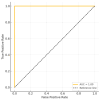Development of a Clinical Risk Assessment Score for Respiratory Distress Due to Respiratory Infections in Early Infancy
- PMID: 40564704
- PMCID: PMC12191812
- DOI: 10.3390/children12060746
Development of a Clinical Risk Assessment Score for Respiratory Distress Due to Respiratory Infections in Early Infancy
Abstract
Background/objectives: Neonatal and infant respiratory distress carries high morbidity, and severity can vary with gestational maturity and perinatal factors. Early risk stratification may improve outcomes, but existing assessment tools do not fully address age-related risk differences. We aimed to develop and validate a Neonatal Clinical Risk Assessment Score (N-CRAS) for predicting severity in neonates and young infants with respiratory distress due to respiratory infection.
Methods: This pilot score was applied exclusively to a cohort of forty neonates and young infants with respiratory distress secondary to infectious causes, as defined by clinical and laboratory parameters. Clinical variables (gestational age, delivery mode, birth weight category, and APGAR score) were recorded and analyzed for associations with illness severity. We developed the N-CRAS (0-5 points) encompassing five indicators of severe illness (respiratory infection, metabolic disorder, need for symptomatic treatment, mechanical ventilation, and intubation), each contributing 1 point. Patients were stratified as low (0-1), moderate (2-3), or high (4-5) risk. Chi-square tests and Spearman correlation assessed associations, and an ROC curve evaluated the score's predictive performance for intubation.
Results: No individual perinatal factor was significantly associated with respiratory illness severity. The N-CRAS increased with infant age (p < 0.05), indicating older infants tended to have more severe disease. All study infants who required intubation fell into the high-risk category (score ≥ 4). The N-CRAS demonstrated excellent discrimination for predicting intubation (ROC area under the curve = 1.00).
Conclusions: In this pilot study, the N-CRAS demonstrated a strong correlation with clinical severity and successfully identified all infants who required intubation. However, given the small cohort size and limited number of severe cases, these findings should be interpreted cautiously. Further external validation in larger and more diverse neonatal populations is essential to confirm its predictive utility.
Keywords: N-CRAS; clinical severity prediction; neonatal respiratory distress; prematurity; risk stratification.
Conflict of interest statement
The authors declare no conflicts of interest.
Figures
Similar articles
-
Heliox for croup in children.Cochrane Database Syst Rev. 2021 Aug 16;8(8):CD006822. doi: 10.1002/14651858.CD006822.pub6. Cochrane Database Syst Rev. 2021. PMID: 34397099 Free PMC article.
-
Systemic pharmacological treatments for chronic plaque psoriasis: a network meta-analysis.Cochrane Database Syst Rev. 2017 Dec 22;12(12):CD011535. doi: 10.1002/14651858.CD011535.pub2. Cochrane Database Syst Rev. 2017. Update in: Cochrane Database Syst Rev. 2020 Jan 9;1:CD011535. doi: 10.1002/14651858.CD011535.pub3. PMID: 29271481 Free PMC article. Updated.
-
Immediate versus deferred delivery of the preterm baby with suspected fetal compromise for improving outcomes.Cochrane Database Syst Rev. 2016 Jul 12;7(7):CD008968. doi: 10.1002/14651858.CD008968.pub3. Cochrane Database Syst Rev. 2016. PMID: 27404120 Free PMC article.
-
Systemic pharmacological treatments for chronic plaque psoriasis: a network meta-analysis.Cochrane Database Syst Rev. 2021 Apr 19;4(4):CD011535. doi: 10.1002/14651858.CD011535.pub4. Cochrane Database Syst Rev. 2021. Update in: Cochrane Database Syst Rev. 2022 May 23;5:CD011535. doi: 10.1002/14651858.CD011535.pub5. PMID: 33871055 Free PMC article. Updated.
-
Continuous subcutaneous insulin infusion versus multiple daily injections of insulin for pregnant women with diabetes.Cochrane Database Syst Rev. 2016 Jun 7;2016(6):CD005542. doi: 10.1002/14651858.CD005542.pub3. Cochrane Database Syst Rev. 2016. PMID: 27272351 Free PMC article.
References
-
- Vincent M., Karolak J.A., Deutsch G., Gambin T., Popek E., Isidor B., Szafranski P., Le Caignec C., Stankiewicz P. Clinical, Histopathological, and Molecular Diagnostics in Lethal Lung Developmental Disorders. Am. J. Respir. Crit. Care Med. 2019;200:1093–1101. doi: 10.1164/rccm.201903-0495TR. - DOI - PMC - PubMed
LinkOut - more resources
Full Text Sources



